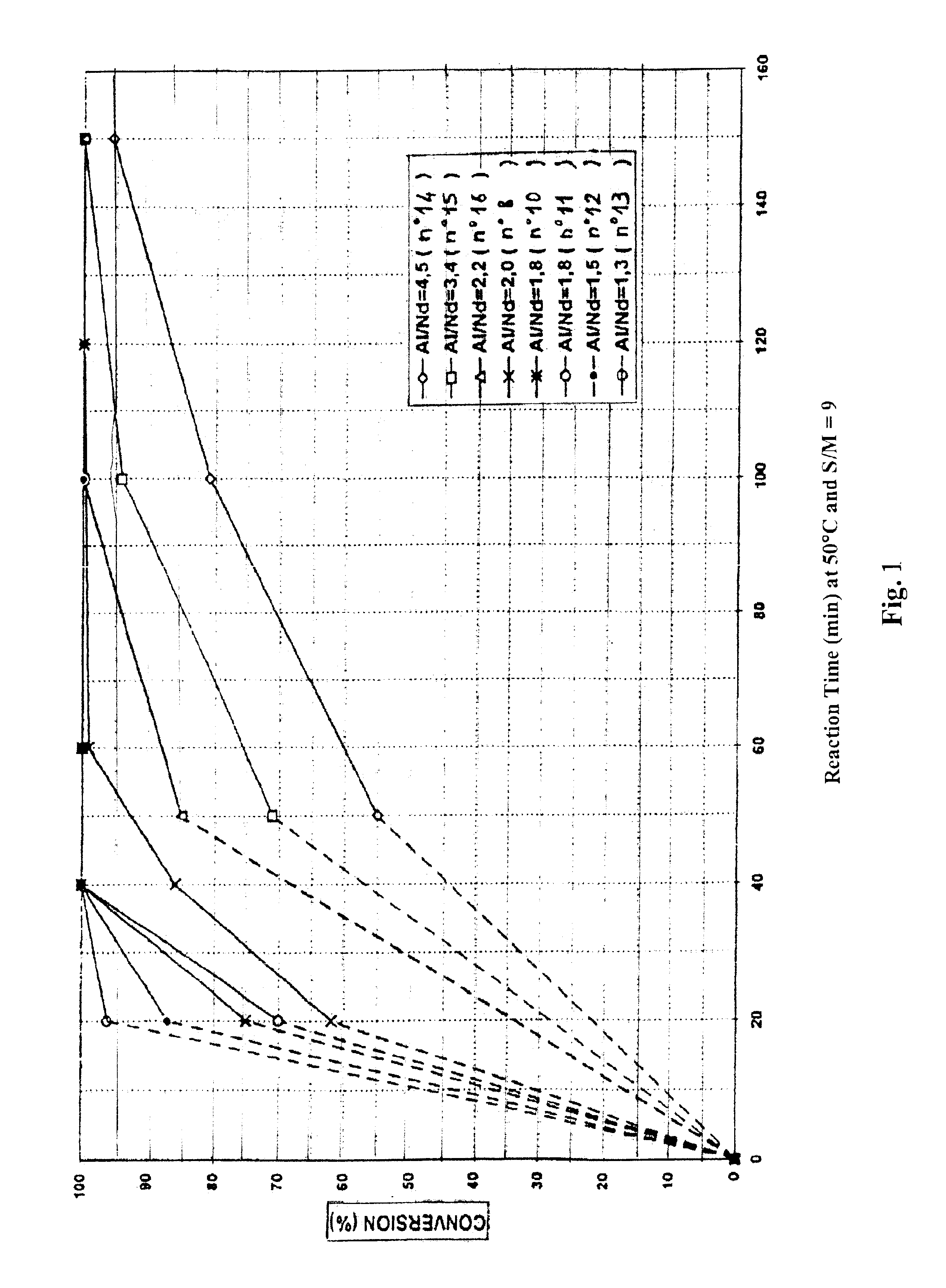Catalytic system and process for the preparation of elastomers by means of this system
a technology of catalytic system and elastomer, which is applied in the field of catalytic system, can solve the problems of different levels of activity, inability to use polybutadienes in tire treads, and inability to achieve the macrostructural and microstructural properties of polymers obtained by means of catalytic system, and achieves the effect of high catalytic activity
- Summary
- Abstract
- Description
- Claims
- Application Information
AI Technical Summary
Benefits of technology
Problems solved by technology
Method used
Image
Examples
example i
PREPARATION OF CATALYTIC SYSTEMS OF THE INVENTION
1) Synthesis of an Organic Phosphate Salt of Neodymium of the Invention:
A plurality of tests were carried out for synthesis of this salt. The same synthesis method, which is described in detail below, was used for each of these tests.
a) Synthesis of an Aqueous Solution of Neodymium NdCl3, 6H2O:
96 g of Nd2O3 (sold by RHODIA), which has been determined by complexation analysis to have an Nd content of 85.3% (theoretical value 85.7%), thereby amounting to 0.57 mol of Nd, was weighed out into a “tall” form 600 ml beaker.
80 ml of demineralized water were added. Under a fume hood, 150 ml of 36 wt. % concentrated HCl (d=1.18), namely 1.75 mol of HCl (molar ratio HCl:Nd=1.75:0.57=3.07), were slowly added at ambient temperature while the mixture was stirred with a magnetic stirrer.
The reaction Nd2O3+6 HCl+9 H2O → 2 NdCl3, 6H2O is highly exothermic.
Once all the hydrochloric acid has been added, the solution was raised to boiling while being sti...
example ii
POLYMERIZATION OF ISOPRENE BY MEANS OF CATALYTIC SYSTEMS T, T′ AND 1 TO 16
1) Operating Method for the Various Polymerizations:
A 250 ml “Steinie” bottle was used as the polymerization reactor (except for the second and third polymerization examples using catalytic system 5, where a 750 ml “Steinie” bottle was used, see Table II below). Each polymerization reaction was carried out by subjecting this bottle to agitation in a water tank.
A steam-cracked C5 naphtha fraction was used with the aim of extracting isoprene therefrom with a purity approaching 100%. To this end, a conventional laboratory purification process was used comprising the following successive steps:distillation of this C5 fraction over maleic anhydride to eliminate any residual cyclopentadiene, followed bypassage through an alumina column to remove polar impurities, andnitrogen bubbling for 20 minutes, immediately prior to the polymerization reaction.
The mass fraction of isoprene extracted from this C5 fraction was det...
example iii
POLYMERIZATION OF BUTADIENE USING CATALYTIC SYSTEMS 14 TO 29
1) Operating Method for the Various Polymerizations:
A 250 ml “Steinie” bottle was used as the polymerization reactor. Each polymerization reaction was carried out by subjecting this bottle to agitation in a water tank.
Each butadiene polymerization reaction (10 g of butadiene were used per bottle) was performed in cyclohexane at 30° C., 50° C. or 60° C. under an inert atmosphere (nitrogen). A “polymerization solvent (cyclohexane):monomer (butadiene)” mass ratio of 7 or 9 was used (said mass ratio is hereafter denoted “S:M”).
The quantity of neodymium catalyst base ranged from 250 μmol to 2000 μmol per 100 g of butadiene, depending upon the test performed (this quantity is stated in μMcm in Table III below). It will be noted that this quantity of neodymium was adjusted on the basis of the “alkylating agent:rare earth salt” ratio with the aim of obtaining final inherent viscosity values which were substantially identical for th...
PUM
| Property | Measurement | Unit |
|---|---|---|
| Temperature | aaaaa | aaaaa |
| Temperature | aaaaa | aaaaa |
| Temperature | aaaaa | aaaaa |
Abstract
Description
Claims
Application Information
 Login to View More
Login to View More - R&D
- Intellectual Property
- Life Sciences
- Materials
- Tech Scout
- Unparalleled Data Quality
- Higher Quality Content
- 60% Fewer Hallucinations
Browse by: Latest US Patents, China's latest patents, Technical Efficacy Thesaurus, Application Domain, Technology Topic, Popular Technical Reports.
© 2025 PatSnap. All rights reserved.Legal|Privacy policy|Modern Slavery Act Transparency Statement|Sitemap|About US| Contact US: help@patsnap.com


